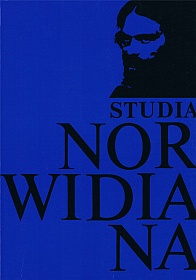Cyprian Norwid - rzeźbiarz. Szkic informacyjny
Abstrakt
Norwid, the great innovator of Polish poetry, also worked creatively in several areas of fine art. He called himself a “craftsman”, which meant that he was able to express himself as freely in the poetry as in sculpture, painting or drawing. Still, our knowledge of Norwid’s achievements as a visual artist continues to be fragmentary and far from complete. Work on the problem has been hampered first of all by the loss of many of Norwid’s works and unavailability of information because of his fortunes as an exile.
Least known is Norwid’s sculpture; yet, we are discovering that sculpture exercised him quite frequently and that he had considerable achievements in this field. This is clear from Norwid’s own texts and from the opinions o f his contemporaries. Norwid’s services to Polish sculpture were described most eloquently by T. Zieliński, an art patron, collector and connoisseur, on a monument he erected in Kielce in 1854 to commemorate artists who had made a particularly valuable contribution to Polish culture. Norwid the sculptor is also mentioned in the published sources of the day, such as E. Rastawiecki’s Słownik rytowników polskich (1886). Norwid studied sculpture in the years 1842-1846 at the Florence Academy of Fine Arts, under the well-kown neoclassicist sculptor L. Pampaloni. We also know that he attended the Academies of Berlin and Brussels, As early as 1843, the artist was getting major commissions for monumental sculpture, mostly from Poland. This testifies to an early recognition of his talent. Norwid’s first sculpted work, which was in fact never executed, was to have been a set of altar figures for the Chlapowskis’ palace chapel at Turwia. Next he worked on designing the statues o f Jan Kochanowski for Cracow and o f Father Augustyn Kordecki for the Paulite fathers of Częstochowa. In 1848 he took active part in the conceptual work on a monument to the fallen scythemen of Great Poland, which was to be erected at Sokołów. From 1850 he designed monuments for the collective graves of Polish emigres in the Paris cemeteries of Montmartre, Neuilly and Montmorency. We know, too, that he executed some, now lost, sculptures in Florence, Rome and New York. Apart from statuary work, he also made medals. Several such works by Norwid are known: in 1850 he presented his medal design to commemorate the formation of the Polish League, in 1860 he made a posthumous medallion o f the poet Zygmunt Krasiński and in 1869 a medal to mark the tricentennial of the Union of Lublin. Only a few of Norwid’s sculptures have come down to us. In the case of some others, we do not even known whether they ever went beyond the stage of a drawing sketch. Norwid’s extant sculptures (the monument of the scythemen at Sokołów, the Paris tomb statue o f P. Łagowski and his comrades, the Krasiński medallion, the Union of Lublin medal) and drawings give us an image of the artist first of all as a maker of patriotic art. It must be stressed that this was the consequence o f deliberate artistic choices and was linked with the aesthetic views that Norwid advocated. Norwid declared art to be an important part of national life and considered sculpture and medals to have a special calling to perform important social and political functions. Their duty was to popularize history, bear witness to our traditions and give evidence on the nation’s present. They were to be “gratitude made public” in commemorating both old and contemporary heroes, artists, poets and thinkers. Hence, the worship of heroes, figures important for the Polish national life, and the commemoration of great historic events circumscribe the domain of both his finished and his projected sculptures. However, Norwid’s proposals are not the mere illustration of events that we might expect from their professed didactic function. They have none of the story-telling or allegorization so typical of the sculpture of the day. Educated on the neoclassical models of the Florence school, the artist followed his own path. The Krasihski medallion is marked by unusual conciseness and sparingness of expression. Norwid’s statue designs show stark obelisks bearing national and religious symbols which, while constituting a commentary on historical events, at the same time carry a general message and in a logically abbreviated form express the elementary universal ideals o f patriotism. Norwid draws on the stock o f traditional symbols (oak and laurel leaves, the sabre, the cross, the column, the torch), but he also introduces his own (the scythe, the plough), derived from the recent Polish history and connected with the popular hero. In accordance with his concept of native character in art, this served to create a new language of Polish iconography. The message o f Norwid’s works is usually supplemented by ideas and reflections testifying to his attitude as an artist which are written down in his notes. His notes are a special record; they demonstrate clear links between his work and his theory. They also enrich our reception of his work by supplying its ideological background and by telling us of the author’s emotions while engaged upon his task.
The present information about Norwid’s work as a sculptor is not meant to glorify his artistic achievement. It is intended to supplement his artistic biography with facts little known today but essential for our image of his work and his views on art.
Copyright (c) 1989 Studia Norwidiana

Utwór dostępny jest na licencji Creative Commons Uznanie autorstwa – Użycie niekomercyjne – Bez utworów zależnych 4.0 Międzynarodowe.





